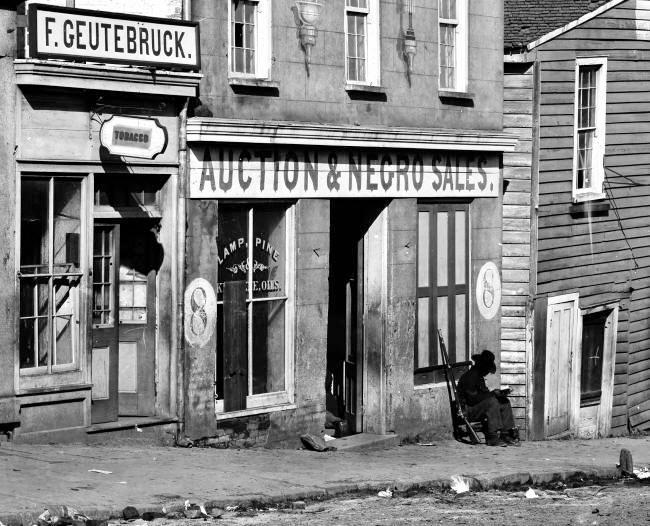
American Domestic Slave Trade: Slave Markets

Figure 1.--This is the storefront of an Atlanta slave dealer sometime in 1864. It might be after Sherman took Atlanta (Septmber) because it looks like a Fedderal soldier sitting outside. Atlanta was a major southern city and a vital hub of the Confederacy's transport system. The all important cotton plantations of the Deep South were mostly located south and west of Atlanta. The storefront doesn't tell us much. Click on the image for a view of what when on inside these storefronts. English artist Eyre Crowe provides us "Slaves waiting for sale", depicting a Richmond, Virginia scene in 1861. Notice how well the slaves being sold are dressed. This basically depicts slaves held in the reltive gentility of slavery in the Upper South being sold to planters in the Deep South.
|
|
Slave markets existed all over the United States, but primarily in the South. Some of the most important were located in Charleston, New Orleans, and Richmond. New Orleans had the largest slave markets in the country. Richmond was the second largest market with some 350,000 slaves sold here (1830-65), nost for transport to the cotton plantations of the Deep South. There was also alave market in the Federal capital, the Dustrict of Colombia. Smaller markets also existed in northern cities like Philadelphia. And most southern cities of any size had small markets. An abolitionist campaigner describes what an American slave market was like. "Few persons who have visited the slave states have not, on their return, told of the gangs of slaves they had seen on their way to the southern market. This trade presents some of the most revolting and atrocious scenes which can be imagined. Slave-prisons, slave-auctions, handcuffs, whips, chains, bloodhounds, and other instruments of cruelty, are part of the furniture which belongs to the American slave-trade. It is enough to make humanity bleed at every pore, to see these implements of torture. Known to God only is the amount of human agony and suffering which sends its cry from these slave-prisons, unheard or unheeded by man, up to His ear; mothers weeping for their children - breaking the night-silence with the shrieks of their breaking hearts. We wish no human being to experience emotions of needless pain, but we do wish that every man, woman, and child in New England, could visit a southern slave-prison and auction-stand." [Brown]
Sources
Brown, William Wells. (1848).
IH

Navigate the Children in History Webite:
[Return to Main American domestic slave trade page]
[Return to Main American slavery page]
[Return to Main American debate over slavery]
[About Us]
[Introduction]
[Biographies]
[Chronology]
[Climatology]
[Clothing]
[Disease and Health]
[Economics]
[Freedom]
[Geography]
[History]
[Human Nature]
[Ideology]
[Law]
[Nationalism]
[Presidents]
[Religion]
[Royalty]
[Science]
[Social Class]
[Bibliographies]
[Contributions]
[FAQs]
[Glossaries]
[Images]
[Links]
[Registration]
[Tools]
[Children in History Home]
Created: 10:09 PM 6/10/2017
Last updated: 10:09 PM 6/10/2017



